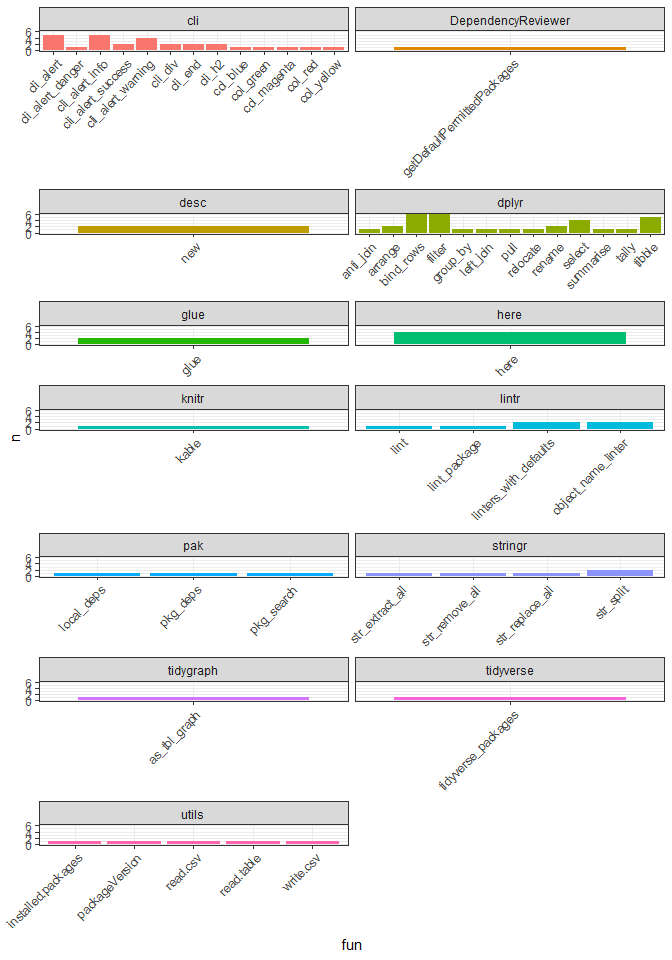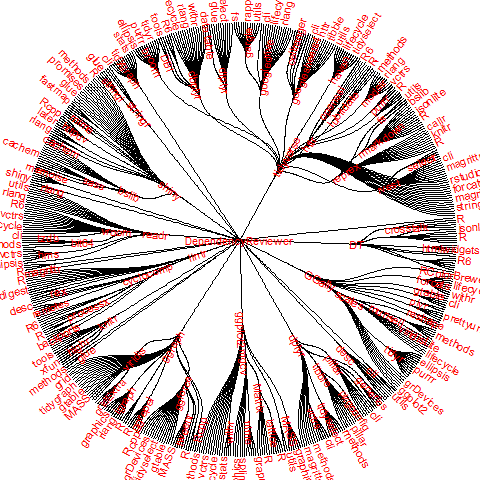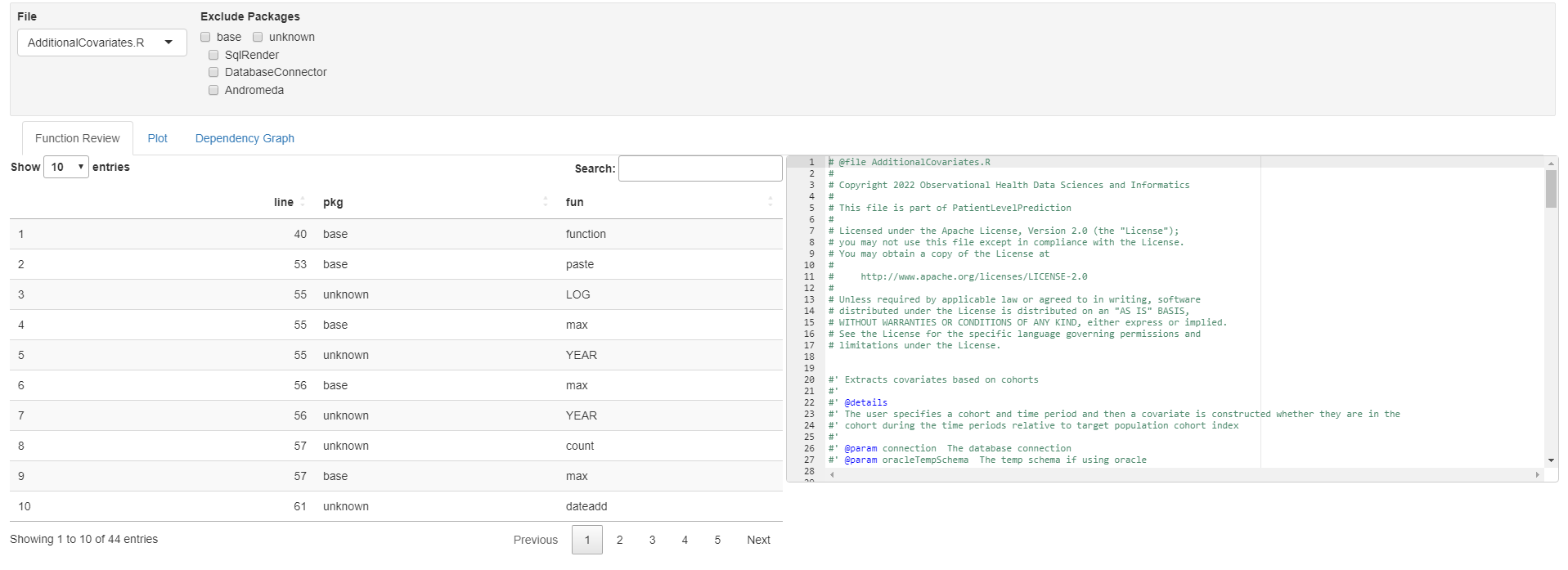
You can install the development version of DependencyReviewer like so:
install.packages("remotes")
remotes::install_github("darwin-eu/DependencyReviewer")Check whether dependencies in the description file are approved and whether the required version matches the current recommendation.
library(DependencyReviewer)
library(dplyr)
library(ggplot2)
library(pander)Without any options set, it will review the package you are currently inside:
checkDependencies()
#> ℹ Loading metadata databaseℹ Loading metadata database✔ Loading metadata database ... done✔ Loading metadata database ... done
#>
#> Writing temp file
#>
#> ── Checking if packages in Imports and Depends have been approved ──
#>
#> ! Found 3 packages in Imports and Depends that are not
#> approved
#> → 1) GGally
#> → 2) lintr
#> → 3) pak
#> ! Please create a new issue at https://github.com/mvankessel-EMC/DependencyReviewerWhitelists/ to request approval for packages with the following message:
#> → |package |version |date | downloads_last_month|license |url |
#> |:-------|:-------|:-------------------|--------------------:|:------------------|:----------------------------------------------------------------|
#> |GGally |2.1.2 |2021-06-21 03:40:10 | 85560|GPL (>= 2.0) |https://ggobi.github.io/ggally/, https://github.com/ggobi/ggally |
#> |lintr |3.0.2 |2022-10-19 08:52:37 | 62675|MIT + file LICENSE |https://github.com/r-lib/lintr, https://lintr.r-lib.org |
#> |pak |0.3.1 |2022-09-08 20:30:02 | 41813|GPL-3 |https://pak.r-lib.org/ |getDefaultPermittedPackages gets a table of all the ‘permitted’ packages in the accompanying csv-file.
pander(head(getDefaultPermittedPackages()))
#> Get from temp file| X | package | version |
|---|---|---|
| 1 | codetools | 4.2.0 |
| 2 | base | 4.2.1 |
| 3 | boot | 4.2.1 |
| 4 | class | 4.2.1 |
| 5 | cluster | 4.2.1 |
| 6 | codetools | 4.2.1 |
Function use of all .R files can be investigated using the
sumariseFunctionUse function. It assumes the function is is ran
inside an R-project, and will automatically look for the files in the
/R folder. Functions where no package could not be found for,
are binned under the unknown package. Usually base functions
are not used as base::mean(). Therefore the function goes
through all the base functions to bin them under the base
package rather than unknown.
r_files <- list.files(here::here("R"))
function_use <- summariseFunctionUse(r_files)
pander(head(function_use))| r_file | line | pkg | fun |
|---|---|---|---|
| checkDependencies.R | 27 | base | function |
| checkDependencies.R | 29 | dplyr | filter |
| checkDependencies.R | 29 | base | is.na |
| checkDependencies.R | 30 | dplyr | rename |
| checkDependencies.R | 31 | dplyr | left_join |
| checkDependencies.R | 33 | base | c |
The output could be plotted like so:
function_sub <- function_use %>%
filter(!pkg %in% c("unknown", "base"))
fun_counts <- function_sub %>% group_by(fun, pkg, name = "n") %>% tally()
ggplot(
data = fun_counts,
mapping = aes(x = fun, y = n, fill = pkg)) +
geom_col() +
facet_wrap(
vars(pkg),
scales = "free_x",
ncol = 2) +
theme_bw() +
theme(
legend.position = "none",
axis.text.x = (element_text(angle = 45, hjust = 1, vjust = 1)))
unknown and base are filtered out, and the functions are being tallied up for each package.
getGraphData allows to easily get graph data for all the dependencies.
graphData <- getGraphData()
library(igraph)
library(ggraph)
ggraph(
graph = graphData,
layout = "dendrogram",
circular = TRUE) +
ggraph::geom_edge_diagonal() +
ggraph::geom_node_text(
check_overlap = TRUE,
mapping = ggplot2::aes(
x = x * 1.005,
y = y * 1.005,
label = name,
angle = -((-ggraph::node_angle(x, y) + 90) %% 180) + 90),
size = 3,
colour = "red",
hjust = 'outward') +
theme_void()
If you would like to investigate dependencies there is a package named PAK that allows you to do various things like that. It is used in DependencyReviewer as a dependency to get all the dependency information.
library(pak)
pkg_deps("darwin-eu/DependencyReviewer")
#> # A data frame: 141 × 32
#> ref type direct direc…¹ status package version license needs…² prior…³
#> <chr> <chr> <lgl> <lgl> <chr> <chr> <chr> <chr> <lgl> <chr>
#> 1 darwin-e… gith… TRUE TRUE OK Depend… 1.0.0 Apache… TRUE <NA>
#> 2 DBI stan… FALSE FALSE OK DBI 1.1.3 LGPL (… FALSE <NA>
#> 3 DT stan… FALSE FALSE OK DT 0.26 GPL-3 … FALSE <NA>
#> 4 GGally stan… FALSE FALSE OK GGally 2.1.2 GPL (>… FALSE <NA>
#> 5 MASS stan… FALSE FALSE OK MASS 7.3-58… GPL-2 … FALSE recomm…
#> 6 Matrix stan… FALSE FALSE OK Matrix 1.5-3 GPL (>… FALSE recomm…
#> 7 R6 stan… FALSE FALSE OK R6 2.5.1 MIT + … FALSE <NA>
#> 8 RColorBr… stan… FALSE FALSE OK RColor… 1.1-3 Apache… FALSE <NA>
#> 9 Rcpp stan… FALSE FALSE OK Rcpp 1.0.9 GPL (>… FALSE <NA>
#> 10 askpass stan… FALSE FALSE OK askpass 1.1 MIT + … FALSE <NA>
#> # … with 131 more rows, 22 more variables: md5sum <chr>, sha256 <chr>,
#> # filesize <int>, built <chr>, platform <chr>, rversion <chr>,
#> # repotype <chr>, repodir <chr>, target <glue>, deps <list>, mirror <chr>,
#> # sources <list>, remote <list>, error <list>, metadata <list>,
#> # dep_types <list>, params <list>, sysreqs <chr>, cache_status <chr>,
#> # lib_status <chr>, old_version <chr>, new_version <chr>, and abbreviated
#> # variable names ¹directpkg, ²needscompilation, ³priorityTo lint your entire package you can use:
darwinLintPackage()Sometimes a package might be to large to lint entirely, so you can lint per file instead
darwinLintFile()Dependency Reviewer now includes a shiny app, which encapsulates all the functionality available in the package. The app consist of two sections:
The shiny app is launched using
runShiny() This panel shows the locations of functions per file. The file can be
changed in the top left. Packages that are found in this file can be
filtered out, if desired.
This panel shows the locations of functions per file. The file can be
changed in the top left. Packages that are found in this file can be
filtered out, if desired.
In a table on the left all functions are shown, with what package they’re from and in what line they’re found in the file. On the right the file being investigated is shown.
 The
Plot panel shows bar plots per package which are found in the
investigated file. Filtering can be used to exclude packages.
The
Plot panel shows bar plots per package which are found in the
investigated file. Filtering can be used to exclude packages.
 In the final tab panel a graph is shown of all packages and their
dependencies. On the left hand side several options are shown. 1)
Layout the layout of the graph; 2) iterations Number
of iterations (if applicable for the selected layout) 3) Number of
Dependency layers the amount of dependencies shown, with
their dependencies, as a slider, or numeric value.
In the final tab panel a graph is shown of all packages and their
dependencies. On the left hand side several options are shown. 1)
Layout the layout of the graph; 2) iterations Number
of iterations (if applicable for the selected layout) 3) Number of
Dependency layers the amount of dependencies shown, with
their dependencies, as a slider, or numeric value.